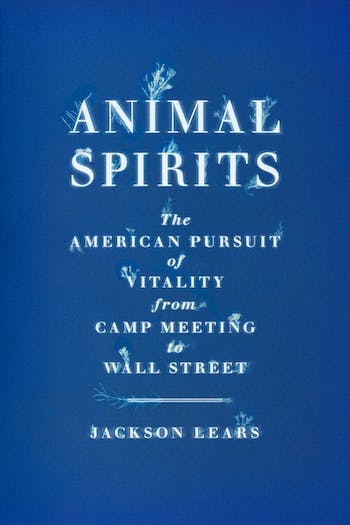Book Review: Jackson Lears’s “Animal Spirits” — A Chronicle of American Zing
By Daniel Lazare
Historian Jackson Lears assembles sightings of a world that’s changeable, mutable, and filled with animalism, vitalism, or whatever else you want to call it. But what’s the point?
Animal Spirits: The American Pursuit of Vitality from Camp Meeting to Wall Street by Jackson Lears. Farrar, Straus and Giroux, 464 pages, $32.
 Based on Jackson Lears’s new book, Animal Spirits, two things about the author are clear: he’s a master of both the arcane and the segue. The first allows him to inform us that the phrase “animal spirits” appeared in Laurence Sterne’s novel Tristram Shandy in 1759, in a newspaper published in Springfield, Massachusetts, in 1794, and in an issue of the Yale Literary Magazine in 1840.
Based on Jackson Lears’s new book, Animal Spirits, two things about the author are clear: he’s a master of both the arcane and the segue. The first allows him to inform us that the phrase “animal spirits” appeared in Laurence Sterne’s novel Tristram Shandy in 1759, in a newspaper published in Springfield, Massachusetts, in 1794, and in an issue of the Yale Literary Magazine in 1840.
The second enables him to pirouette so gracefully from one reference to another that it’s almost as if they all add up to a coherent whole, even though they don’t. Sterne used “animal spirits” to refer to the seed that a man plants in the womb at the moment of conception, with the woman, in the 18th-century view, serving as nothing more than an empty receptacle. The Springfield Federal Spy used the term to describe the sympathy and imagination that a beggar might seize on in order to stir up “a thousand sudden conjectures and pre-occupations in his favor.” The Yale Lit used it in the opposite sense, to describe something that is low and base. Thus, “good music … seldom produces a high flow of the animal spirits, but rather a sober cheerfulness favorable to serious thoughts and feelings.”
So animal spirits can refer to sperm, to the imaginative faculties, or to the urge to do the Locomotion to the music of Little Eva. In other words, it can mean nearly anything and the opposite. So what do all the sightings that Lears assembles add up? The answer is unclear.
Not that he’s lazy or unenergetic. Quite the contrary, Lears takes us on a vigorous tour that begins with the Cree of northern Canada, whose sense of an animated world led them to view hunting as a kind of spiritual rendezvous between man and beast, and then moves on to the Hopi of the Southwest, who likewise believe in a coexistence of the material and the spiritual; to Ovid’s Metamorphoses, in which humans and animals constantly change into one another; to the Eucharist, in which a wafer and wine are “transubstantiated” into the body and blood of Jesus Christ; to Teddy Roosevelt galloping “full of animal spirits” through Yellowstone National Park, and then to Ethel Merman displaying “memorable animal spirits” (in the words of the Washington Post) in a 1938 Hollywood romance called Happy Landing.
Yes, it all adds up to a world that’s changeable, mutable, and filled with animalism, vitalism, or whatever else you want to call it. But what’s the point? Lears scatters about mini-portraits of various sorts, some of which seem sensible and some of which do not. An example of the latter is a dozen-page profile of John Maynard Keynes, who famously used animal spirits to describe “the spontaneous urge to action” on the part of capitalist investors. Keynes is a hero of Lears, and so his profile is one-sided and uncritical. “By acknowledging the centrality of torrential irrational forces in human affairs,” he informs us, “his emerging outlook resonated with the musings of Freud, Conrad, Bergson, and other Modernists.” He quotes Keynes at another point as saying about his and his Cambridge classmates’ political development, “We repudiated entirely customary morals, conventions, and traditional wisdom. We were, that is to say, in the strict sense of the word, immoralists.”
So Keynes was not a bland managerialist, as some might think, but a rambunctious bohemian. This is interesting, certainly. But not only is its connection with animal spirits uncertain, but the portrait leaves a great deal out, such as the minor detail that Keynesian economic theory was in such ruins by the 1970s that the unholy duo of Ronald Reagan and Margaret Thatcher had no trouble ramming through neoliberalism. Although Lears describes Keynes as a social democrat, he also leaves something else out: his snobbery and right-wing politics. Dismissing Bolshevism on the grounds of purest elitism, he wrote in 1925, “How can I adopt a creed which, preferring the mud to the fish, exalts the boorish proletariat above the bourgeois and intelligentsia who, with whatever faults, are the quality in life and surely carry the seeds of all human advancement?” Refusing to join the British Labor Party, he added during the Depression that Labor is “a class party, and the class is not my class. The class war will find me on the side of the educated bourgeoisie.”
Lears leaves such quotes on the cutting-room floor because that is what dutiful left-Keynesians are supposed to do. He does better when he gets to Norman Mailer a dozen or two pages later, but, then, Mailer is a target of barn-side proportions. He refers to him, inaccurately, as an “anarcho-socialist,” when in fact, courtesy of his friend Jean Malaquais, he hovered on the edges of the Trotskyist movement, which was decidedly hostile to anarchism. But he does a good job of zeroing in on his many contradictions and absurdities. Filled with loathing for the stuffy petty bourgeoisie, Mailer by 1957 was celebrating the angel-headed hipster as someone who lives “the life where a man must go until he is beat, where he must gamble through all his energies, through all those small or large crises which beset his day, where he must be with or be doomed not to swing.” (Paging Maynard G. Krebs…) Swooning over John F. Kennedy, he wrote that JFK “was a hero America needed, a hero central to his time, a man whose personality might suggest contradiction and mysteries which could reach in the alienated circles of the underground, because only a hero can capture the secret imagination of a people, and so be good for the vitality of his nation; a hero embodies the fantasy and so allows each private mind the liberty to consider its fantasy and find a way to grow” — and so on in that deeply cracked Mailer way.
Lears points out that the erstwhile Marxist was celebrating someone who “attacked Nixon from the right, asserting that the Republican administration had ‘lost’ Cuba to communism and promising a more confrontational approach to the Soviet Union. The latter involved the invention of a ‘missile gap’ between the two notions as an excuse for accelerating the nuclear arms race and extending an already considerable US advantage.” Lears adds: “But style was another matter. And Mailer was concerned with nothing if not taste and style.”

Historian Jackson Lears. Photo: Macmillion
All of which is sharp, funny, and incisive. Good liberal that he is, Lears goes on to slam Reagan for his Strategic Defense initiative, otherwise known as Star Wars, and for “his triumphalist resurrection of American power and virtue, after the shameful loss in Vietnam.” He writes that NATO expansion into eastern Europe “would eventually provoke the proxy war with Russia over Ukraine” — which it in fact did, even though the Washington Post and New York Times continually insist that Russia alone is to blame. He attacks prowar journalists like George Packer, a longtime staffer at the New Yorker, for playing “an important supporting role in … resurrecting faith in regenerative war” after 9/11, which is on-target as well.
But what does it all have to do with animal spirits? Again, no one knows. Animal Spirits does marshal an argument of sorts, but it’s exceedingly muddy. Animalism, vitalism, and whatnot, it suggests, all connote a universe in motion, one filled with contending forces that are constantly changing into one another. It’s a “vision of universal animacy” that “has miraculously come to seem scientific again.” Such animacy may seem dialectical, but it lacks the essential Hegelian elements of progress and direction. Instead, it’s just a swirl for its own sake, one whose only purpose is to swirl and then swirl some more.
Animal Spirits includes a head-scratcher of an epilogue filled with green-ish musings about “technocratic domination; the rejection of an ethos of human mastery over manipulable nature; the recovery of respect for nonhuman creatures,” etc. “Emphasizing what humans have in common with the rest of the natural world allows for our participation alongside other creatures in an interdependent, animated universe,” Lears writes. “And a clearer understanding of our relationship to nature demands a sensitivity to the ways that organisms engage with the contingent circumstances of their environment in historical time.”
Not quite. The problem with “a clearer understanding of our relationship to nature” is that it doesn’t lead to an enhanced partnership with beavers and squirrels, but to the opposite, i.e. better science and hence greater human domination — domination that is more sophisticated in its understanding of natural complexity, but domination nonetheless. After all, science is something that homo sapiens have and no one else. It’s at the core of human sovereignty, something that is not going away soon. Indeed, modern sovereignty theory, which goes back to Jean Bodin and Thomas Hobbes, holds that it can’t go away because the only limit on an all-powerful sovereign is his inability to surrender his own sovereignty. So humans can’t surrender it either. All they can do is make it better by making it more intelligent, more advanced, and therefore more comprehensive. Instead of dancing from one obscure animal-spirits reference to another, Lears would be better off focusing on the specific philosophical and political issues that his survey raises but fails to adequately address.
Daniel Lazare is the author of The Frozen Republic and other books about the US Constitution and US policy. He has written for a wide variety of publications including Harper’s and the London Review of Books. He currently writes regularly for the Weekly Worker, a socialist newspaper in London.
